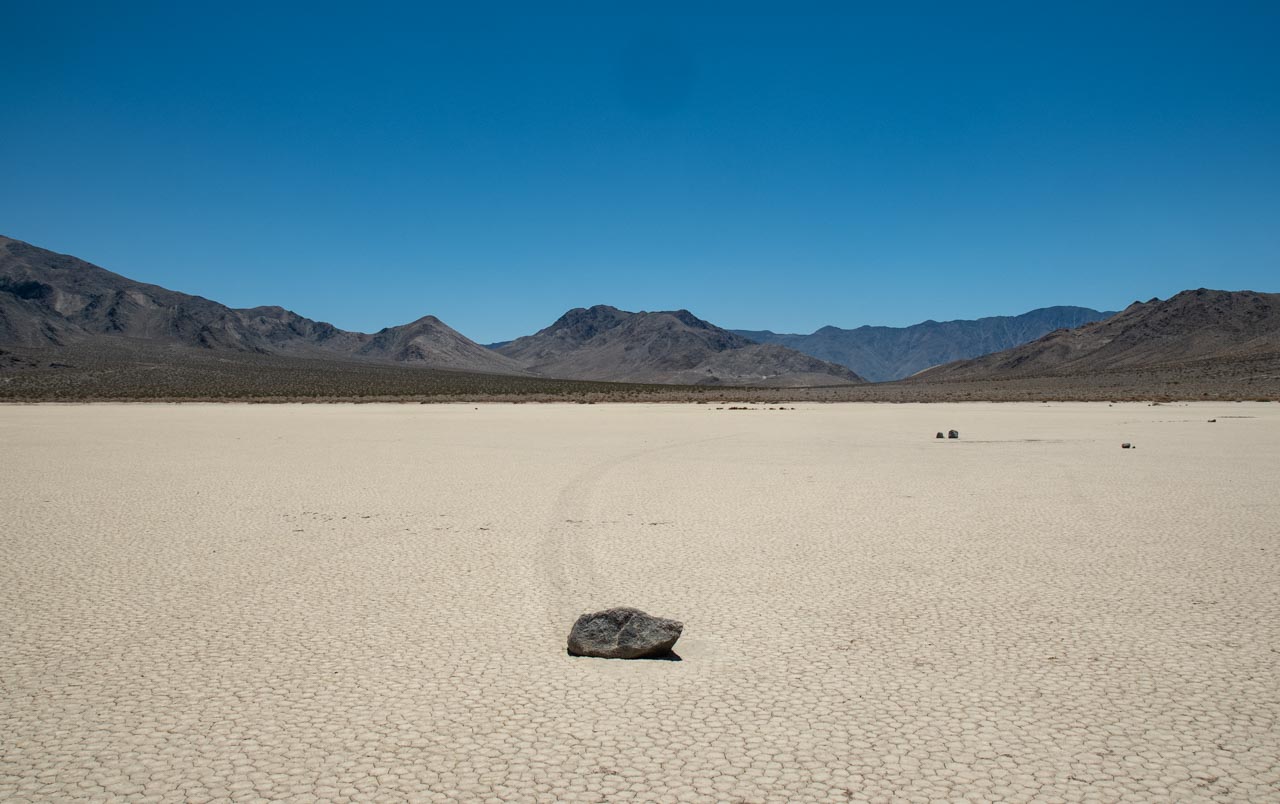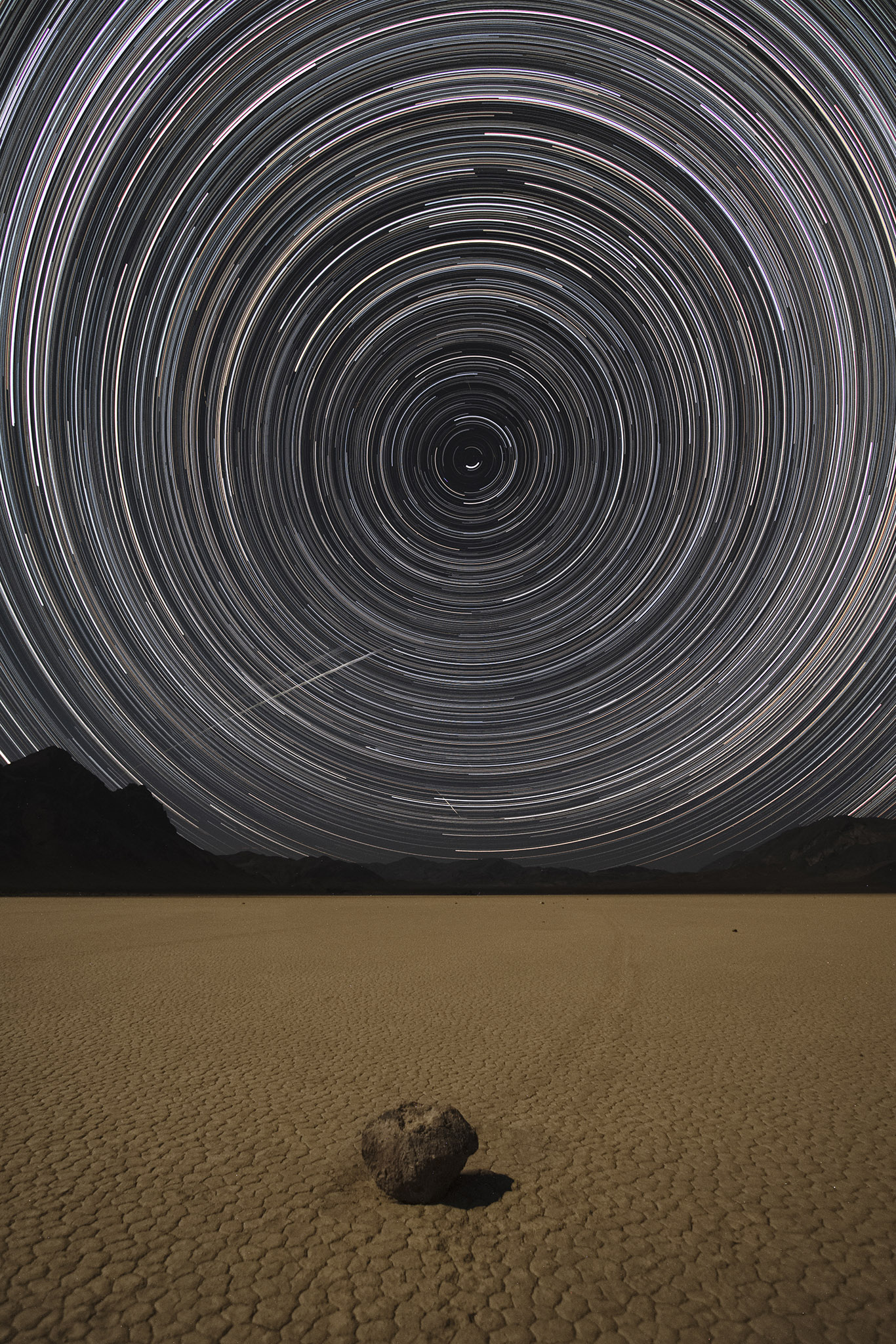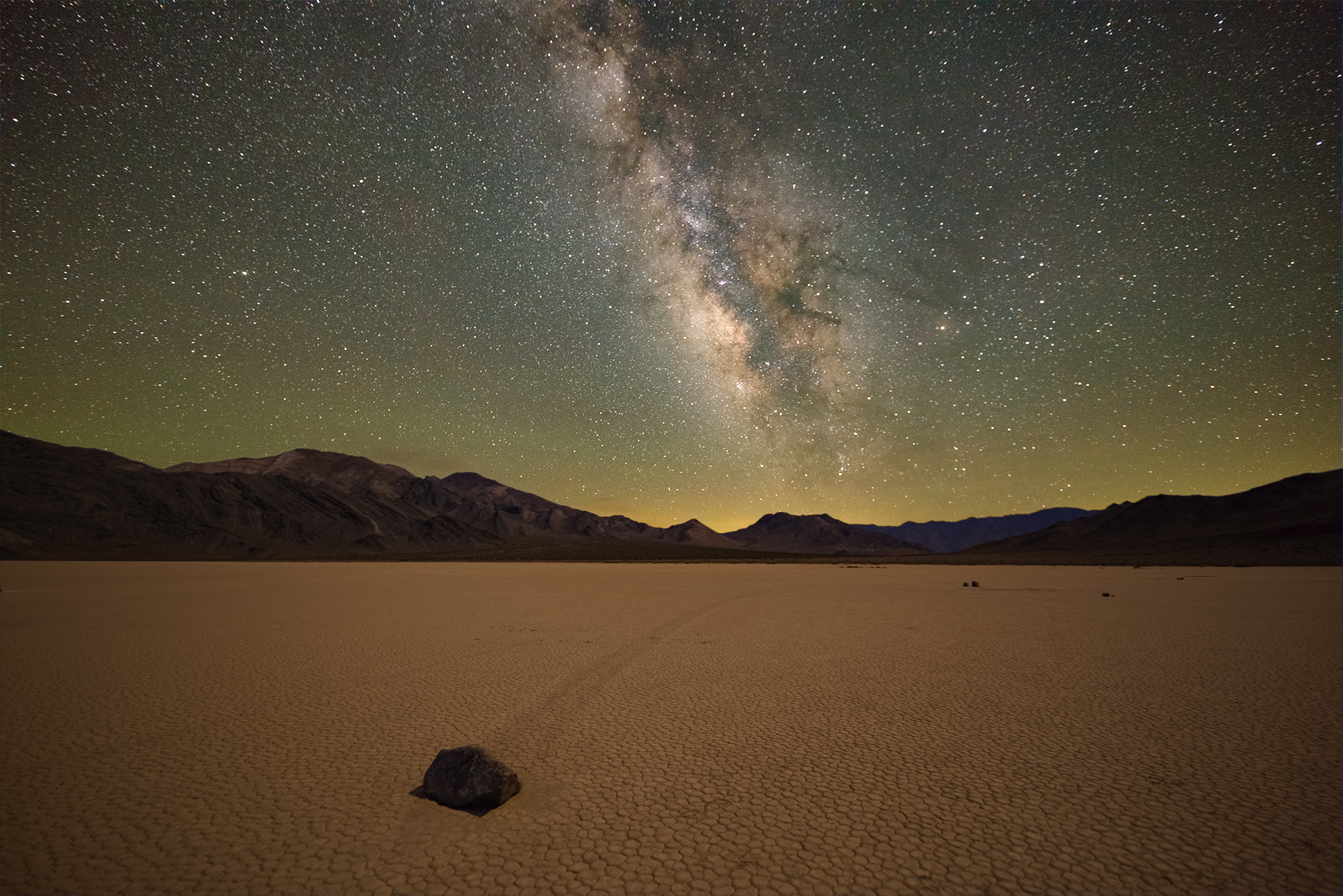
There was a second wide spot in the road at the south end of the playa; we parked and continued our explorations. This time we found stones sitting on the surface of the lakebed. There were not many, and we had to hike a mile or so to find them. Some sat happily contemplating their position in the uniform semi-infinite plane of mud cracks. Others showed a faint trail of disturbed, and now solidified mud, leading to their current position. These were the famous sailing stones!
We also found trails that led to an empty dent in the ground—where a stone had vanished. These stones had been removed by disinformed magic seekers. I like to think that removing a sailing stone from its track will bring a later rebalance of karma to the person who would commit such a desecrating act.
Despite the discouraging number of empty trails, I found two stones that I thought were photogenic. Interestingly, they had arrived at their destinations from completely opposite directions. One was a south bearing rock, the other was headed north. This was great for my plans to have a camera facing in each direction. Inspired by this creative moment, I marked them on my GPS as “Stone 1” and “Stone 2”.
My nighttime photo session would have to wait until… well, nighttime. Meanwhile, it was mid-afternoon in Death Valley. We were no longer below sea level, but the temperature was still above 100F. We retreated to the dry campground a mile south of the playa, hoping to find shade. We didn’t. So we pitched our 2-person backpacking tent (adequate for 1, questionable for 2) but found that it sequestered the heat. Only by deploying a mylar reflective space blanket could we tolerate the shade it provided. My personal weather station recorded the temperature at nearly 115 degrees.

We passed the hours in an afternoon siesta, occasionally rising to fix the protective mylar sheath from the wind, and to monitor the temperature and our hydration. The desert heat is a dry heat. We regulate our internal temperatures by perspiring, and cooling from the evaporation. When the air is dry, this works really well, and we don’t even notice the amount of water that has left our bodies from our skin surface.
After a while however, with the loss of fluid, we end up being thirsty. The amount of water that has been sent through the skin for evaporative temperature control is much more than we usually consume. A half-liter water bottle will just not make up for it. This is why people still die in Death Valley.
This was not our risk however. We had plenty of water. Too bad we had not loaded up on ice.
Our siesta ended and we headed back to our trailhead for Stone 1 and Stone 2. I assembled my camera gear, tripods, power supplies, and time lapse equipment. Poldi prepared an evening meal that we enjoyed while we watched the sun approach the western mountains and the temperature started to ease.
My stone subjects were about a half mile onto the playa. Several trips were needed to transport my gear, plus one more to go back and (not) get the GPS that I thought I had left behind but was actually still in my pocket. As I was setting up and composing my cameras for their nighttime assignments, Poldi transported some additional gear: tarp, blanket, sleeping bags, some water, flashlights and other items. She laid them out carefully, protecting the delicate surface of the playa, exactly between the two cameras, just out of view from both.
It takes all day for the sun to set, but when it does, it seems like it is over in a flash. I rushed to keep the camera settings matching the rapidly declining light. After sunset comes the period of civil twilight, followed by nautical twilight, and then astronomical twilight, each needing a different exposure. We don’t sense how dramatic the light level change is—our eyes have an auto-gain feature that let us keep seeing details despite the encroaching night.
At the end of astronomical twilight, the sun has fallen 18 degrees below the horizon, and now night officially begins. But on this night, a half-moon was out, providing plenty of light for humans to navigate. My cameras however, had reached their limits and were now on their time lapse settings that would last all night. There was nothing more for me to do.
I joined Poldi at the oasis she had made for us in the desert. The sleeping bags were deployed but the temperature was still too warm to climb in. We were at that transition from the heat of day and the cool of night where the temperature is perfectly neutral; we watched the stars come out and the moon beam its reflected light down on our landscape.
The romantic power of moonlight, and of being in such a strangely beautiful, exotic and remote place is irresistible. And so, despite the day’s heat and dust and grime, we responded to the emotions that surfaced as we gazed at the sky and at each other, lovers lit by moonlight with a backdrop of stars in the middle of the playa.
The night continued its magical sequence. The temperature dropped and we retreated to our sleeping bags, occasionally waking to find ourselves immersed under a full sky of stars. Each time a new view presented itself: the setting of the moon, the rising of the Milky Way, the Big Dipper circumnavigating Polaris.

Eventually, 4:00 am arrived and I had to get up to tend the cameras for their morning twilight schedule. It would be days before I found out if they were successful in capturing the motions of the sky that night. But what a night it had been! As we gathered our stuff at sunrise to portage back to the car at lake’s edge, we thought back on the experience. This was not going to blend in among the many other outings we have enjoyed. It will stand out as a highlight of a lifetime.
To those who remove them, I must explain that the magic of the sailing stones is not in the stones themselves; rather it infuses the place where they make their remarkable journeys. We know this because we felt the magic all around us during our night on the playa.



Pingback: A Night on the Playa, Part 1 | Thor's Life-Notes
The stills are beautiful; the time-lapses amazing! Thanks for bringing me along for this life highlight!
Pingback: Polaris on the Playa | Thor's Life-Notes